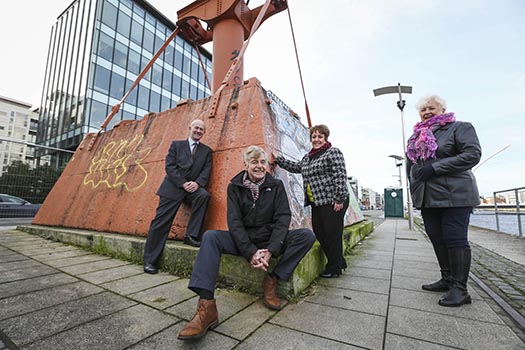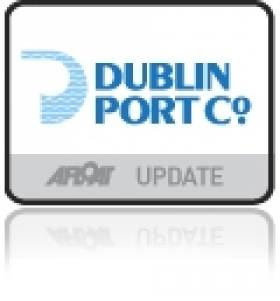Displaying items by tag: Diving Bell
Timelapse Video Of Dublin Port Diving Bell Restoration
#DublinPort - The Dublin Port Company has posted this incredible timelapse video of the four-month restoration of the capital's 129-year-old diving bell.
As previously reported on Afloat.ie, the Docklands mainstay opened as Dublin's newest tourist attraction this past July, with interpretive panels detailing its use in the construction of the Liffey quay walls from the late 19th century till the 1950s.
Its original designer, Bindon Blood Stoney, was also the engineer responsible for such landmarks as O'Connell Bridge and the Boyne Viaduct bridge in Drogheda.
Still having pride of place on Sir John Rogerson's Quay, the diving bell is now elevated an extra two metres allowing access for the public underneath.
Diving Bell Used To Repair Irish Sea Power Cable
#DivingBell - Engineers worked 82 feet beneath the surface of the North Channel to repair a seabed cable linking Northern Ireland's power grid with Scotland.
According to HeraldScotland, the repair crew used a diving bell style device to safely reach the site some 4km from the Scottish mainland and fix the break in the Moyle Interconnector.
The N-Sea 'incubator' design is a more modern version of the diving bell design used in the construction of Dublin's deep-water quays between the 1870s and 1950s.
Dublin Port's Diving Bell To Be Restored As Visitor Centre
#DublinPort - Dublin Port's 140-year-old diving bell is set to be restored as a tourist attraction, as the Irish Independent reports.
The diving bell was first used in construction of the capital's deep-water quays in 1871, allowing for water to be pumped out and air to be pumped in for workers to make the river bed level, acting like a mobile caisson.
It was last used in the building of quayside walls as recently as 1958, and following a campaign to save it from the scrapheap in the 1980s it was moved to its present location on Sir John Rogerson's Quay.
Now it will form the basis of a new interpretive centre to be readied this June, where visitors will be able to access the 90-tonne device from beneath and learn more about its fascinating history.
The Irish Independent has more on the story HERE.
More from Dublin Port Company:
Have you ever passed by the odd looking, bell-shaped, red metal structure standing tall on Sir John Rogerson's Quay and wondered what it is? You could be forgiven for thinking it is a modern art sculpture or misplaced mound of metal. It is in fact an ingenious feat of Irish engineering that was essential in building Dublin's quay walls for 87 years. This is Dublin Port's "Diving Bell".
Dublin Port Company today announced a new project that will shed light on this important artefact and will transform the Diving Bell into a new interpretive exhibition that explains its origin and history.
The Diving Bell was designed by the port engineer Bindon Blood Stoney (1828 to 1907) and built by Grendon and Co., Drogheda. It was delivered to the Port in 1866, entered service in 1871 and was used in the building of the Port's quay walls until 1958. Stoney was a prodigious engineer and among his achievements were the building of the Boyne Viaduct in Drogheda, the construction of O'Connell Bridge and the building of many of the Port's quay walls including Sir John Rogerson's Quay and North Wall Quay Extension.
The Diving Bell was used in the building of the Port's quay walls from the Victorian era right up until almost the 1960s. It was a ground-breaking piece of engineering innovation in its day.
Its lower section was hollow and bottomless, providing just enough room for six men to work at a time. Once lowered into position on the riverbed, the crew entered through an access funnel from the surface and compressed air was fed in from an adjacent barge. The men inside the bell worked on the river bed exposed at their feet, excavating the site where a massive concrete block would later go; all the excavated soil was stashed in trays hanging inside the bell, and brought up when the bell was lifted.
The project, which commences this week and opens in mid-June 2015, will elevate the 13m tall, 90 tonne Diving Bell onto a two metre steel structure, creating a ramped public access route underneath. A water feature will also be installed beneath the structure accompanied by a series of interpretative panels explaining the historical, social and engineering significance of the Diving Bell. The new exhibition will be illuminated at night time using energy efficient LED lighting.
The project has been designed with the expertise of a range of people including the architect Sean O'Laoire, the sculptor Vivienne Roche, Tom Cosgrave (professor of engineering at the University of Limerick) and Mary Mulvihill of Ingenious Ireland.
This is the first project in Dublin Port's plan to create a 'distributed museum' of attractions across the Dublin docklands and into Dublin Port to preserve the port's industrial heritage and history.
Weslin Construction Ltd. has been appointed to carry out the project, which will be completed by mid-June 2015, when the newly reconfigured Diving Bell will open again to the city.

Pictured at the announcement are: Eamonn O'Reilly, Chief Executive, Dublin Port Company, Sean O'Laoire, Director of MOLA Architecture, Dolores Wilson, St. Andrews Resource Centre and Betty Ashe, St. Andrews Resource Centre
Eamonn O'Reilly, Chief Executive, Dublin Port Company said: "The Diving Bell is a remarkable feat of Irish engineering and Dublin Port Company is proud to invest in its transformation and bring the history of this magnificent structure to life along the Liffey. True to the commitment in our Masterplan, we are working to better integrate Dublin Port and the city. Developing the Diving Bell is the first step in our plan to create a distributed museum of port and industrial heritage attractions across the Dublin docklands and into the port. We are confident that the Diving Bell will give Dubliners and visitors to the city a true sense of Dublin as a port city with a wealth of industrial heritage to discover."
Betty Ashe of St. Andrew's Resource Centre, Pearse Street, said: "I am delighted that the next phase of the Diving Bell Project is now underway, having been involved in a Millennium project with St. Andrew's Resource Centre, the DDDA and Dublin Port Company to save and restore this fascinating artefact from the Victorian era. As a port community, we have a duty to preserve local history for future generations. I thank Dublin Port Company for sharing that vision and giving the Diving Bell a prominent place in the history books for this community and our city."




























































